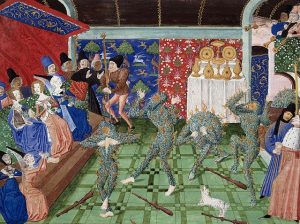Wholly unexpected events were one of the things the Game of Thrones series used to its advantage. One of the most shocking was the third season’s “Red Wedding”, where leading members of the protagonist Stark family were massacred at a wedding reception. Today marks the 628th anniversary of an equally shocking event albeit one that involved neither murder nor intent.
Today, history knows King Charles VI of France (1368-1422) as “Charles the Mad.” In April 1392, Charles experienced the first of 44 attacks of madness. The attacks lasted from three to nine months and were interspersed with three- to five-month periods of sanity for the rest of his life.
His queen, Isabeau of Barvaria, evidently believed that lavish parties she threw would help alleviate the king’s madness. Thus, on January 28, 1393, she decided to hold a masquerade ball, supposedly to celebrate the third marriage of her lady-in-waiting. The ball was a charivari, which historian Barbara Tuchman characterizes as having “all sorts of license, disguises, disorders, and loud blaring of discordant music and clanging of cymbals[.]” One nobleman came up with the idea that he and five cohorts, including King Charles, should masquerade as “wood savages.” Their costumes consisted of of linen cloth sewn onto their bodies and soaked in resinous wax or pitch to hold a covering of frazzled hemp, “so that they appeared shaggy and hairy from head to foot.” That’s right, pitch. You know, the extremely flammable tar-based resin. Maybe you can see where this is going.

Le Bal des Ardents
According to Tuchman, when the wood savages entered the ball, they “capered before the revelers, imitating the howls of wolves and making obscene gestures while the guests tried to discover their identity.” Because of the costumes, torches were forbidden. However, the king’s brother, Louis of Valois, staggered into the party drunk with a lit torch. As the “savages” were near impossible to identify, Louis had the bright idea of holding his torch close to the face of one of them. The highly flammable costume quickly ignited and as the man ran in panic to put out the flames the other flammable men caught fire. Guests who tried to douse the flames and tear the costumes from the victims were badly burned.
Charles VI, however, was saved by the 15-year-old Duchess of Berry. Amid the chaos, she had the presence of mind to wrap the train of her dress around the king to extinguish the flames. One other wild man jumped into a vat of wine (or dishwater, depending on who’s relating the story). One of the remaining four men died at the scene, two died two days later and, in what might be considered a bit of poetic justice, the noble who came up with the idea suffered for three days before dying.
The event, which came to be known as Le Bal des Ardents (the Ball of the Burning Men), caused “great commotion” in Paris. King Charles would ride in solemn procession to Notre Dame to appease the people. Behind him, the king’s brother and uncles followed barefoot as penitents. Louis also sought to atone for his actions by building a chapel at the Celestine monastery in Paris. That monastery no longer exists.
The king’s second episode of madness occurred in June 1393. Lasting about seven months, he insisted he was not King Charles VI and was unable or unwilling to recognize his wife, to whom he was persistently hostile. There were occasional brief periods during this time when he seemed relatively lucid. Eventually, though, the bouts would worsen, even to the point that Charles came to believe he was made of glass and would shatter if he was touched. At least fire doesn’t slay glass; it only melts it.
This ghastly affair, coming so soon after the King’s madness, was like an exclamation point to the malign succession of events that had tormented the century.
Barbara Tuchman, A Distant Mirror: The Calamitous 14th Century







